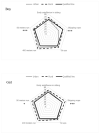Nutritional status, food consumption, lifestyle, and physical fitness in rural and urban elementary school children in Northeast China
- PMID: 36407515
- PMCID: PMC9667101
- DOI: 10.3389/fnut.2022.1044877
Nutritional status, food consumption, lifestyle, and physical fitness in rural and urban elementary school children in Northeast China
Abstract
Childhood obesity is observed not only in developed countries but also in some developing countries in Asia, where low physical activity and poor physical fitness have been reported. The primary goal of weight loss is to reduce body fat mass, thereby reducing the risk of metabolic syndrome. Unfortunately, a concomitant decrease in lean mass, including muscle mass, is often observed when weight is lost. This study aimed to clarify the nutritional status and physical fitness of local elementary school children and to investigate the factors associated with nutritional status. This study evaluated measures that can reduce the tendency toward obesity and recommends exercise that can reduce weight while maintaining or increasing muscle strength. A total of 911 elementary school children were recruited for this study. All the participants completed anthropometric measurements, dietary surveys, and physical fitness tests. Compared with the Chinese obesity criteria, the proportions of obese and overweight subjects were generally high [22 (rural girls) to 47% (urban boys)], and urban children had a higher obesity rate than rural children. Overall, rural children had better physical fitness test results than urban children did. Skipping rope was correlated with muscle mass. Exercise time (β = -0.31, p < 0.01), skipping rope (β = -0.25, p < 0.01), screen time (β= 0.23, p < 0.01); sit-ups (β = -0.20, p < 0.01); 400-m run (β = -0.19, p < 0.01); urban or rural area (β = 0.18, p < 0.01); oil intake (β = 0.15, p < 0.01), family income (β = 0.11, p < 0.05); and sex (β = -0.10, p < 0.05) were significant predictive factors for overweight and obesity, respectively. The diet of schoolchildren can be improved by reducing the intake of grain and edible oils. Physical fitness of schoolchildren can be improved by increasing exercise time and selecting exercises with higher metabolic equivalents. Rope skipping appears to be the best option because it can ameliorate obesity by increasing muscle strength. The results of this study can provide a reference for the development of obesity intervention methods for children in China and worldwide.
Keywords: China; food consumption; nutritional status; obesity; physical fitness.
Copyright © 2022 Liu, Liu, Wang, Yan and Hao.
Conflict of interest statement
The authors declare that the research was conducted in the absence of any commercial or financial relationships that could be construed as potential conflicts of interest.
Figures
References
-
- Abarca-Gómez L, Abdeen ZA, Hamid ZA, Abu-Rmeileh NM, Acosta-Cazares B, Acuin C, et al. Worldwide trends in body-mass index, underweight, overweight, and obesity from 1975 to 2016: a pooled analysis of 2416 population-based measurement studies in 128. 9 million children, adolescents, and adults. Lancet. (2017) 390:2627–42. 10.1016/S0140-6736(17)32129-3 - DOI - PMC - PubMed
-
- Zhu Z, Tang Y, Zhuang J, Liu Y, Wu X, Cai Y, et al. Physical activity, screen viewing time, and overweight/obesity among Chinese children and adolescents: an update from the 2017 physical activity and fitness in China-the youth study. BMC Public Health. (2019) 19:197. 10.1186/s12889-019-6515-9 - DOI - PMC - PubMed
LinkOut - more resources
Full Text Sources


